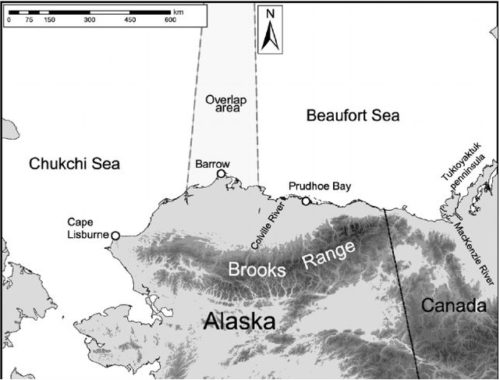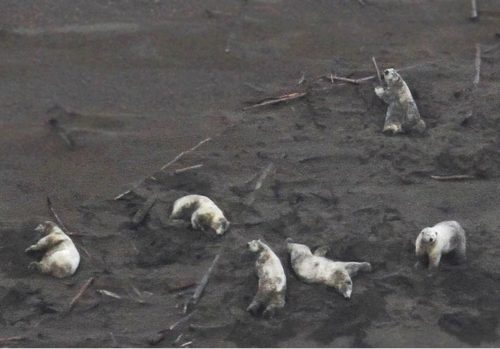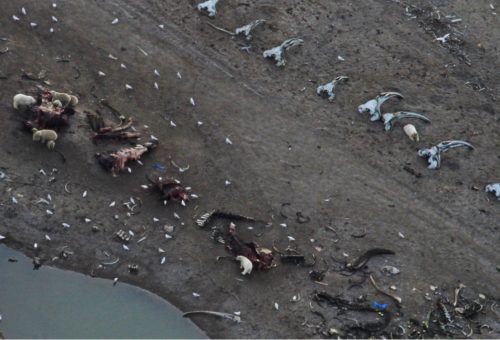This aerial shot of six fat polar bears lolling around on a sandy beach on the coast of the Southern Beaufort Sea, Alaska, was taken by NOAA employees in July 2019.
It exemplifies the reality that bears in this subpopulation are currently abundant and healthy, negating the suggestion that numbers have continued to drop since 2006 because bears are starving.
The above picture of polar bear health is not an exception but the rule for all 31 bears recorded onshore last July, as the photos below from other locations testify.
Those who would blame this abundance of bears on lack of sea ice in 2019 should note that ice retreated as early and as extensively in 2017 yet only three bears were spotted onshore.
Results of a recent (2017-2018) population survey, which has not yet been made public, will of course not reflect conditions seen in 2019.

According to an official NOAA blog report by Vicki Beaver, independent aerial marine mammal observer to NOAA’s ASAMM team [my bold] – see pdf here:
“July 2019 tallied more polar bear sightings than any previous July since ASAMM Beaufort Sea summer surveys began back in 2012. Previously, seven bears was ASAMM’s record for the most bears seen in July on sea ice or land or in open water, for the western Beaufort and eastern Chukchi seas combined.
This July we had 38 polar bears! Thirty. Eight.
While it may seem like a good thing to see so many bears, we cannot assume that increased sightings equals an increasing population. In fact, it may be quite the contrary.
Historically, polar bears in the Beaufort Sea spent their entire year on sea ice, except for females that spent winter in dens on the coastal plain. Recently, an increasing number of polar bears are coming ashore in the western Beaufort Sea and they are arriving earlier, leaving later, and staying for longer periods overall.
From 2012 to 2018 during the month of July, ASAMM recorded only three polar bears on shore. Those three bears were seen in 2017, a year when sea ice retreated earlier in the season than most other years. In July 2019, 31 of the 38 bears recorded were seen on shore.
This is happening because of sea ice decline. Arctic sea ice in 2019 tied with 2007 and 2016 for the second lowest sea ice extent since modern recordkeeping began in the late 1970s.
A marked decline in sea ice coverage and an increased period of ice absence in the southern Beaufort Sea in September has been documented over the last 15 years.”
Well, yes – she would say that seeing more bears doesn’t mean there are more bears: that’s the official line to explain any and all increases in recent onshore sightings or problems with bears (even though in the 1980s, seeing more bears did mean more bears).
By her own admission, 2017 had an early retreat of sea ice in the Southern Beaufort, yet only three bears were seen onshore during the July portion of the summer survey, so she explains away this contradiction by talking about trends.
However, citing 30-year trends in sea ice decline to explain events one specific time is a PR stunt: it’s a way of spinning information to suit the narrative but scientifically, it makes absolutely no sense.
A look at the ice record for those two years (2017 and 2019) shows very little difference in the Southern Beaufort: there was some ice remaining in the western portion both years by the beginning of July but the rest was virtually ice-free.
By mid-July, there was actually more ice off the Alaska coast in 2019 than there was in 2017 (both images below) and yet there were only three bears spotted onshore during July in 2017 but 31 in 2019:
There is going to have to be a better story than ‘not enough ice’ to explain the abundance of fat, healthy polar bears seen in July 2019 on the Beaufort coast.
I will also point out that since these bears were right off the ice in July, they did not get fat from feeding on last year’s whale carcasses, as shown below: they got fat from their spring feeding.
Nine fat bears, including mothers with cubs, were found attracted to 2018’s picked-over whale carcasses near Prudhoe Bay at Cross Island in late July 2019 (below): the first bowhead of the season in 2019 was not taken until 29 August.
Also from the report, regarding bears at whale carcasses [my bold]:
“Prior to 2019, the earliest ASAMM has recorded large aggregations of polar bears was August 15, in 2016 (13 bears). In 2019, ASAMM documented 20 polar bears on Cross Island by late July.
Throughout the remainder of the 2019 field season, ASAMM continued to see high numbers of polar bears along the western Beaufort Sea coast on several occasions. On October 23, ASAMM documented 32 polar bears – mostly mothers with cubs – on Cross Island.“
These bears were fat enough in July to easily survive a 4-5 month fast like the bears do in Western Hudson Bay, who typically fast from early July to November.
Read rest at Polar Bear Science






















